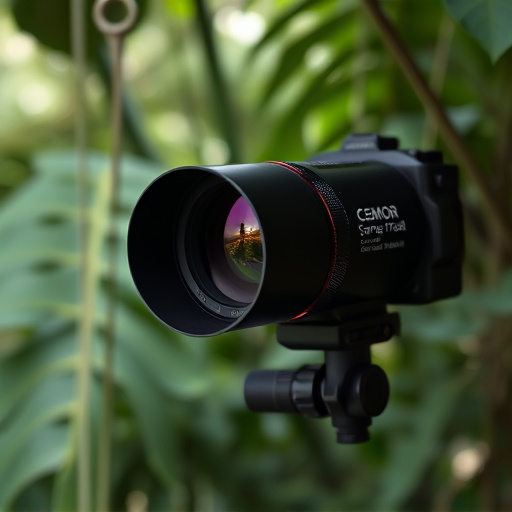Wireless hidden cameras in apartments have become a concern due to their increasing sophistication, prompting advancements in detection methods. The text highlights a lighting-based approach using LED light analysis to identify these covert devices. This strategy, combined with AI and regular inspections, offers solutions to combat unauthorized surveillance. Additionally, it emphasizes the importance of education, thorough checks during turnover or renovations, and advanced surveillance systems to prevent the installation of Wireless Hidden Cameras for Apartments, ensuring tenants' privacy and peace of mind.
Unveiling hidden cameras has become a critical concern, especially in private residences. This article delves into the world of Wireless Hidden Cameras for Apartments, offering a comprehensive guide to their identification. We explore the science behind light-based detection methods, providing practical insights on how to uncover disguised cameras. From understanding the technology to implementing preventative measures, this resource equips readers with knowledge to protect their personal spaces. Learn about the latest techniques and stay ahead in navigating this modern privacy challenge.
- Understanding Wireless Hidden Cameras: A Comprehensive Overview
- The Science Behind Light-Based Camera Detection Methods
- Practical Application: Using Lights to Identify Disguised Cameras in Apartments
- Future Implications and Prevention Techniques for Hidden Camera Detections
Understanding Wireless Hidden Cameras: A Comprehensive Overview
Wireless hidden cameras, also known as apartment surveillance cameras, have become increasingly sophisticated tools for home security. These devices offer a discreet way to monitor living spaces, providing peace of mind for tenants and landlords alike. Understanding how they work is essential for effective deployment and ensuring privacy.
These cameras utilize wireless technology, often connecting via Wi-Fi or cellular networks, allowing them to transmit video feeds directly to a connected device. This enables remote monitoring from anywhere with an internet connection. Whether it’s a landlord checking on a vacant property or a tenant ensuring the safety of their home, these wireless systems offer convenience and control. The market offers various options tailored for apartments, each with unique features like motion detection, night vision, and cloud storage, catering to different security needs and preferences.
The Science Behind Light-Based Camera Detection Methods
The detection of wireless hidden cameras, particularly in sensitive environments like apartments, has evolved significantly with advancements in light-based technologies. These methods leverage the fact that many covert cameras use LED lights for operation, emitting specific wavelengths and patterns that can be detected by specialized equipment. The science behind this involves a deep understanding of optics, photodetection, and signal processing.
Light-based camera detection systems analyze the unique spectral signatures of LED lights used in hidden cameras. By studying the intensity and timing of light signals, these systems can identify patterns indicative of camera activity. This approach is particularly effective in apartment settings where natural lighting variations can be minimized, making it easier to distinguish between normal light fluctuations and those caused by a covert camera’s operation.
Practical Application: Using Lights to Identify Disguised Cameras in Apartments
In the realm of apartment security, identifying hidden cameras is a significant concern. Wireless hidden cameras for apartments have become increasingly sophisticated, making them hard to detect with traditional methods. However, a novel approach using lights offers a practical solution. By strategically placing and manipulating lighting, residents or property managers can uncover these disguised camera setups. This technique involves analyzing the behavior of light reflections and shadows, which can reveal the presence of hidden lenses or sensors, ultimately helping to ensure tenant privacy.
The application of this method is straightforward. During routine inspections or when suspecting unauthorized surveillance, adjusting lighting conditions can prompt cameras to activate, exposing their locations. For instance, shining a bright light directly at walls or ceilings where cameras might be installed could trigger them to capture light and reflect it back, creating visible patterns that give away their presence. This simple yet effective strategy empowers individuals to take proactive measures against invasive privacy breaches in their homes, rendering wireless hidden cameras less of a covert threat.
Future Implications and Prevention Techniques for Hidden Camera Detections
With the constant evolution of technology, the detection and prevention of hidden cameras become increasingly complex. As more advanced Wireless Hidden Cameras for Apartments enter the market, developers must stay ahead to create effective countermeasures. Future research should focus on enhancing existing detection methods, such as employing artificial intelligence to analyze lighting patterns and irregular image data, which could provide early warnings when suspicious devices are detected.
Prevention techniques will play a pivotal role in combating this growing concern. Educating residents about the potential risks and visibility of hidden cameras is essential. Implementing security protocols that require thorough inspections during apartment turnover or renovations can help identify and remove such devices. Additionally, leveraging advanced surveillance systems that incorporate infrared technology and motion detection could serve as robust deterrents, making it more challenging for unauthorized individuals to install Wireless Hidden Cameras for Apartments without detection.
The exploration of wireless hidden camera identification through light-based detection methods offers a promising approach to tackling the growing issue of surveillance privacy invasions, particularly in residential settings. As technology advances, so do the tactics used by those aiming to invade personal spaces through discreetly placed cameras. However, the methods discussed in this article present a robust and non-intrusive way to identify and mitigate these hidden threats, ensuring a safer and more secure environment for apartment dwellers. By understanding the science behind light detection and its practical applications, we can stay ahead of malicious actors who attempt to employ wireless hidden cameras in apartments, fostering a sense of security and peace of mind for residents.
